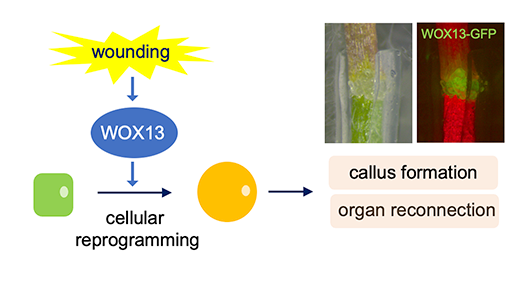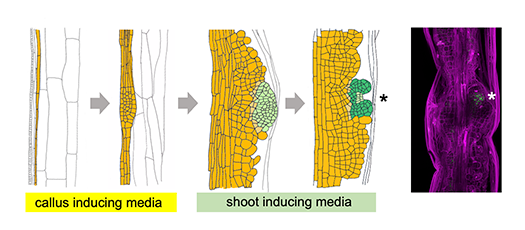Plant Regeneration and Morphogenesis

- Associate Professor
- IKEUCHI Momoko

- Labs HP
- https://bsw3.naist.jp/ikeuchi/
Outline of Research and Education
Why can plants readily regenerate their bodies upon injury? We pursue secrets of plants’ regenerative capacity using molecular genetics, live imaging and single cell transcriptome analyses. Uncovering the secrets of plants’ regenerative capacity will potentially benefit human life by improving various aspects of agricultural biotechnology including grafting and tissue culture.
Major Research Topics
Mechanisms of tissue repair and grafting
Plants develop callus upon injury to heal wound sites, yet regulatory mechanisms of callus formation and tissue repair remain elusive. We recently identified WUSCHEL RELATED HOMEOBOX 13 (WOX13) as a key regulator of callus formation and organ adhesion in Arabidopsis thaliana (Ikeuchi et al., 2022, Fig. 1). Strikingly, wox13 mutant is totally deficient in organ reconnection in petiole grafting system, suggesting that WOX13 is pivotal for the establishment of organ reconnection. In addition to our continued efforts to uncover molecular genetic regulation on tissue repair, we also pursue cell biological aspects of organ re-connection.
Developmental mechanisms underlying shoot regeneration
De novo organogenesis is a mode of regenerative response which is characteristic to plants. In tissue culture-based de novo shoot formation, preculture of tissue explants on auxin-rich media provokes pluripotent callus formation, which is followed by the induction of shoot apical meristem (SAM) formation on cytokinin-rich media (Fig. 2). However, regulatory mechanisms of cellular reprogramming and self-organization of multicellular system during SAM formation remain largely elusive. We have identified transcription factors and epigenetic regulators that regulate these processes. Furthermore, we have identified novel mutants through forward-genetic screening. We combine these molecular genetic approaches with cutting edge imaging and single cell transcriptome analyses to reveal developmental mechanisms of de novo SAM establishment.

Upon injury, WOX13 expression is rapidly induced, which in turn induces cellular reprogramming and cell wall reorganization. This process is pivotal for callus formation and the establishment of organ reconnection in grafting.

In tissue culture, shoot apical meristem (SAM, highlighted by asterisk) arise from calli. GFP signal in the fluorescent image (right) shows WUSCHEL expression, which is observed in SAM.
References
- Ogura et al., Science Advances, 9, eadg6983, 2023
- Tanaka et al., Plant and Cell Physiol., 64, 305-316, 2023
- Ikeuchi et al., Plant Physiol, 188, 425-441, 2022
- Ikeuchi et al., Ann. Rev. Plant Biol, 70, 377-406, 2019
- Ikeuchi et al., Plant and Cell Physiol, 59, 765-777, 2018
- Ikeuchi et al., Plant Physiol, 175, 1158-1174, 2017
- Iwase et al., Plant Cell, 1, 54-69, 2017
- Ikeuchi et al., Nature Plants, 1:15089, 2015

 NAIST Edge BIO(
NAIST Edge BIO(